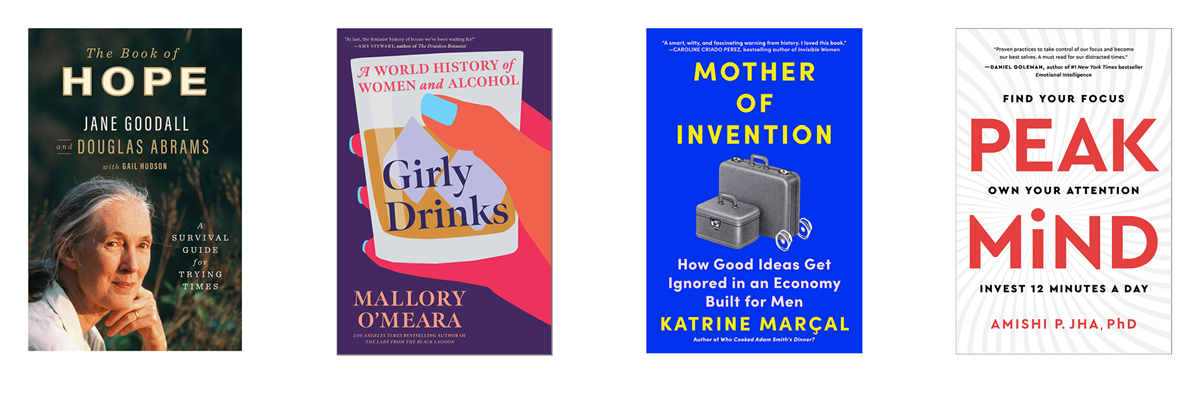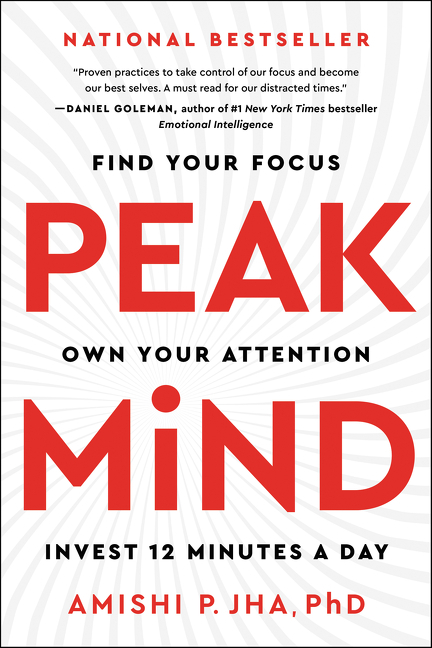Books to Watch | October 19, 2021
October 19, 2021
Each and every week, our marketing team—Dylan Schleicher (DJJS), Gabbi Cisneros (GMC), and now Emily Porter (EPP)—highlights a few new books we are most excited about.
This week, our choices are:

The Book of Hope: A Survival Guide for Trying Times by Jane Goodall & Douglas Abrams, Celadon Books
Jane Goodall is known for her groundbreaking work with chimpanzees and conservational work to protect the environment. In her new book, The Book of Hope, we sit down with Goodall and co-author Douglas Abrams conversing in a raw dialogue about the one thing that may keep humans alive or keep us going through the hard times in life: Hope. We are living during trying times to say the least, but through this captivating conversation with one of the most inspiring individuals alive today, Jane Goodall reminds us of past trials that we overcame and other reasons to continue hoping for the best in this world.
Hope...is what enables us to keep going in the face of adversity. It is what we desire to happen, but we must be prepared to work hard to make it so.
This book focuses on Jane’s Four Reasons for Hope: The Amazing Human Intellect, The Resilience of Nature, The Power of Young People, and The Indomitable Human Spirit. Abrams does a wonderful job playing devil's advocate, mentioning all that we have been through—a global pandemic has swept through our lives, climate change progresses, poverty and violence seem to be everywhere, a political scene that makes everyone cringe permeates our existence—and asks Jane questions that we are all thinking during this difficult time in history. She comes back with sincere answers that spark joy and, yes, even hope within the reader. If ever we needed a book full of hope, I’d say now is that time, and coming from none other than the astounding Jane Goodall at that. Throughout this uplifting text, Goodall takes us on her life’s journey. We see her living through wars, grieving a departed partner, and even meet a young Jane who was unsure of herself. Yet, hope was always around the corner—as it is today. A must read for anyone who wants an extra spark of, well, hope. (EPP)
Girly Drinks: A World History of Women and Alcohol by Mallory O'Meara, Hanover Square Press
Girly Drinks by Mallory O’Meara tells the stories of fifteen women who had an impact on alcohol culture, but it also smartly includes the contexts of those stories.
The history of alcohol and drinking is an amalgamation of anthropology, chemistry, sociology, culinary history, economics, politics, and science.
Luckily, you don’t have to have any depth of knowledge in any of those -ologies to understand and thoroughly enjoy Girly Drinks. O’Meara’s descriptions and histories of alcohol and its many varieties are fascinating and accessible. I especially appreciate her cheeky asides and the additional info in the footnotes. And while the discoveries and developments of beer, wine, mead, sake, vodka, and more across time are fascinating, what is most surprising to me are the eras and civilizations in which women seem to have greater representation and equality than I expected and maybe even more than what they have in some societies today. (GMC)
Mother of Invention: How Good Ideas Get Ignored in an Economy Built for Men by Katrine Marçal, Abrams
Katrine Marçal’s 2016 book, Who Cooked Adam Smith’s Dinner, was about how the work of women has historically been hidden—relegated to a supporting role or unrecognized altogether—and unpaid. Marçal’s new book uncovers how the history of invention and innovation has been affected by the dismissal and social disappearance of women. For instance, electric cars were invented at the same time as gas-powered automobiles but quickly earned a reputation as a vehicle for women—mainly because they were quiet and clean—and were marketed as such. Then they disappeared for over a hundred years. We don’t know what would have happened if the electric car had not been feminized, but:
What we can say, however, is that few things shape our thinking as deeply as our ideas about gender. They influence which machines we choose to build.
And what future we are able to envision for ourselves.
Our inventions should not focus on catering to women, but should involve women and the contributions they have made to the history of invention. It will make things better for us all. The technologies we’ve invented to birth and sustain life are literally softer (pottery, flax) than those we have invented to take life (bronze, iron), so there aren’t epochs or ages named after them, but they shaped our everyday lives as humans far more. As Marçal writes:
When women are removed from the narrative, humankind becomes something else. And so we continue, in this way, to deceive ourselves about our very nature. One of the gravest consequences of the patriarchy is that it makes us forget who we really are.
If we instead took those aspects of the human experience that we have coded as female and recognized them as universal, we could change our entire definition of what it means to be human.
The greatest threat to our individual existence throughout most of our history has been the world around us, and many of our inventions were meant to overcome or subdue that threat. But that’s not the whole story, because the world around us is also our only source of sustenance and survival. If we’re going to sustain life on Earth, especially in an age of climate change, we have to use other tools, more malleable rather than male-able. We must learn a different way to innovate. Luckily, we already have it. We just need to change the narrative. Or, rather, we must tell the whole story. Reading books written by Katrine Marçal will help. (DJJS)
Peak Mind: Find Your Focus, Own Your Attention, Invest 12 Minutes a Day by Amishi P. Jha, HarperOne
Amishi Jha doesn’t think you’re paying enough attention. In fact, she knows you’re probably not, because she has been studying the issue for 25 years and understands that distractibility is an inherent part of the human condition, the way the human mind naturally works. Jha is the co-founder of the Mindfulness Research and Practice Initiative at the University of Miami, and currently serves as its Director of Contemplative Neuroscience. As she explains, our distractibility, once a tool to help us survive, is now undermining our ability to thrive:
Our distractibility served us well when predators lurked around every corner. However, in today’s technologically saturated world, we’re feeling that distractibility more than ever, and we face new predators that rely on and exploit our distractibility.
We now live in an attention economy where our very focus is up for sale, but as Jha points out, we “can only use our attention in the here and now—in this moment,” which means we have ultimate control over this precious commodity. We just have to maintain our control over it. The most important three things to know in that effort is that our attention is powerful, fragile, and trainable. It is that last one that is so critical for us today, because, as she writes: “there is nothing wrong with your attention. In fact, it’s working so well, and so on cue, that computer programs can predict how it will respond. We’re in a crisis because our attention works so well.” Trying to fight a constant war against those distractions is not a winning strategy. What we need to do is learn how to pay attention to our attention, which means retraining how our brains work. She knows it can be done, because Jha and her team at the University of Miami have helped people in some of the most stressful and mentally demanding jobs—firefighters, athletes, business and medical professionals—do just that. Her new book translates those lessons to the page, using mindfulness training to update our standard way of thinking and increase our awareness and attention not only in our everyday, but in every moment. (DJJS)







